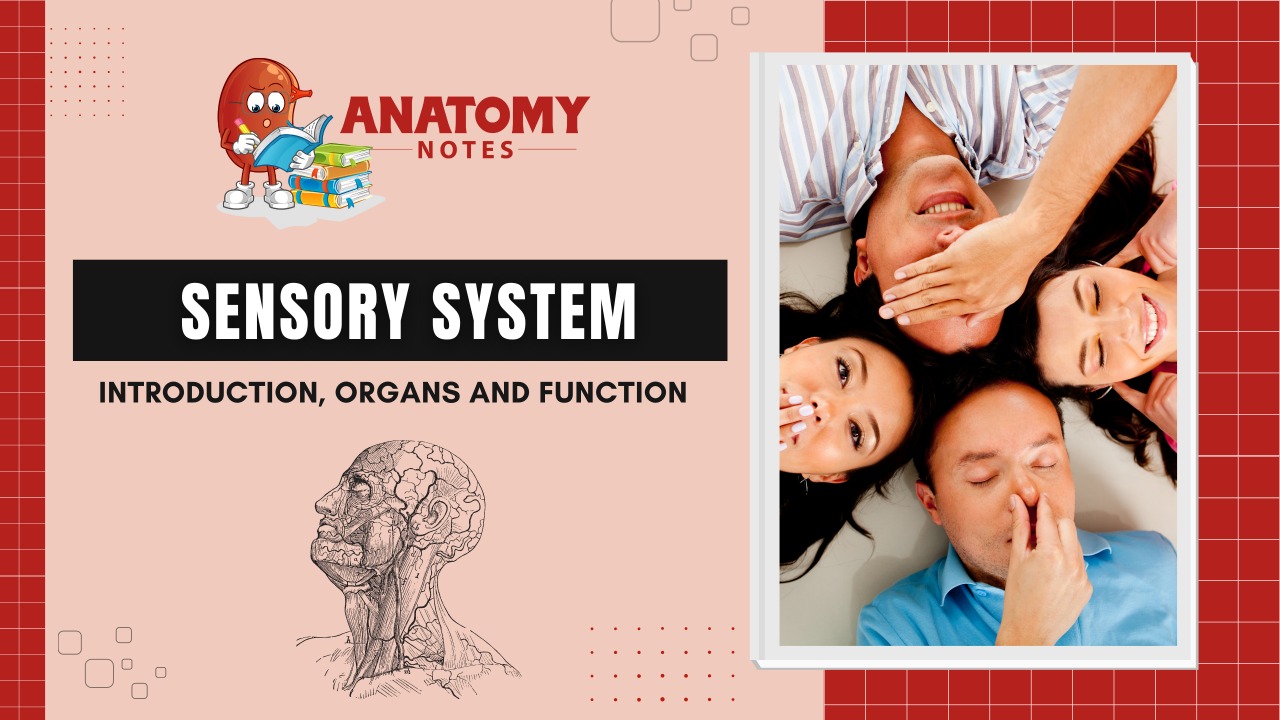The sensory system represents an integration of the functions of the PNS and CNS. The Sensory Division of the Peripheral Nervous System gathers information about the Body’s Internal Conditions and External Environment.
The human experience is affected by both internal and external stimuli. Humans are able to distinguish among many different types of stimuli by means of a highly developed system of a sense organ.
The sensory system translates light, sound, temperature, and other aspects of the environment to electrical signals and transmits these signals, in the form of Action Potentials, to the Central Nervous System, where they are Interpreted.
The overview of sensation
There are millions of neurons in the body that do not receive impulses from other neurons. Instead, these neurons which are called sensory receptors, react directly to stimulation from the environment.
Many Receptors that enable the Body to receive information from the environment are located in highly specialized Organs called sense.
Examples of stimulation include light, sound, motion, chemical, pressure, pain or changes in the temperature.
Once these Sensory Receptors are Stimulated, they transform one form of energy from the Environment (LIGHT, SOUND) into another form of energy (ACTION POTENTIAL) that can be transmitted to other neurons. These Action Potentials (IMPULSES) reach the Central Nervous System (CNS).
In the sensory system, a Sensory Receptor is a Neuron that is Specialized to detect a Stimulus. There are many kinds of Sensory Receptors, and they can be categorized on the basis of the type of stimuli they respond to:
Also Read: The Urinary System-Introduction, Functions and Anatomy
https://anatomynotes.org/urinary-system/the-urinary-system-introductionfunctions-and-anatomy/
Types of Sensory Neurons
• Mechanoreceptors – respond to Movement, Pressure, and Tension.
• Photoreceptors (RODS AND CONES) – Respond to Variations in Light.
• Chemoreceptors- respond. to Chemicals.
• Thermoreceptors – Respond to Changes in Temperature.
• Pain receptors – Respond to Tissue Damage – PAIN!
6. The sensory receptors are contained in the sense organs.
7. Each of the five senses (sight, hearing, smell, taste, and touch) has a specific sense organ associated with it.
8. The most familiar Sense Organs are the eyes, ears, nose, skin and taste bud. These Organs have a receptor that can respond to Stimuli by producing nerve impulses in a Sensory Neuron.
9. The Receptors convert the energy of a Stimulus into electrical energy that can travel in the nervous system.
10. Receptors inside the body inform the CNS about the conditions of the body.
11. Temperature receptors throughout the body detect Changes in Temperature. This information travels to the hypothalamus, which helps control body temperature.
12. Specialized cells (Receptors) within each sense organ enable it to respond to particular stimuli.
13. Messages from Sense Organs to the CNS are all in the form of Nerve Impulses. How does our brain know whether incoming impulse is sound or light?
14. This information is built into the “WIRING” in the Pathways of Neurons that Synapse with each other, and into the location in the Brain where the information arrives.
15. The Brain knows if the information received is from a Sensory Neuron that comes from light receptors cells when it gets the message.
Classification of sensory organs:-
• Taste – The ability to detect chemicals in food, minerals and harmful substances such as poison and it is also known as gestation. The taste bud on the tongue acts as a sensory organ for these detections. A taste bud is divided into five basic tastes: sweet, bitter, salty, sour and umami.
• Smell – The ability to detect the smell which is close to related to the sense of taste and it is also known as olfaction. The olfactory receptors in the nose act as the sensory organ to sense the smell of chemicals from food or floating in the air.
• Touch – Touch or somatosensory perception is perceived by activation in neural receptors in the skin.
The main sensation comes from pressure applied to these receptors, called mechanoreceptors. The skin has multiple receptors that sense levels of pressure from gentle brushing to firm as well as the time of application from a brief touch to sustained.
There are also receptors for pain, known as nociceptors, and for temperature, called thermoreceptors. Impulses from all three types of receptors travel through the peripheral nervous system to the central nervous system and the brain.
• Hearing- It is also called an audition, which is the perception of sound. Sound is comprised of vibrations that are perceived by organs inside the ear through mechanoreceptors.
• Sight- It is also called vision, which is the ability of the eyes to perceive images of visible light.
Learn More:
Frequently Asked Questions (FAQs)
What organs are sensory?
There are several organs in the body that are considered sensory organs. These include the eyes, ears, nose, tongue, and skin. These organs are responsible for receiving various types of sensory information from the environment. This information is then transmitted to the brain for processing and interpretation.
What are the 5 sense organs and their functions?
The 5 sense organs are:
- Eyes – responsible for detecting light and converting it into signals that can be interpreted by the brain as visual images.
- Ears – responsible for detecting sound waves and converting them into signals that can be interpreted by the brain as auditory information.
- Nose – responsible for detecting odors and sending signals to the brain for interpretation.
- Tongue – responsible for detecting taste sensations, such as sweet, sour, salty, bitter, and umami.
- Skin – responsible for detecting touch, pressure, pain, and temperature sensations, and transmitting them to the brain for interpretation.
All these sense organs work together to provide us with a complete understanding of our environment and help us respond appropriately to various stimuli.
What is the importance of the sense organs?
The sense organs are important because they allow us to perceive and interact with our environment. Without them, we would not be able to see, hear, smell, taste, or touch the world around us. The functions of the sense organs include:
- Alerting us to potential danger – for example, the sense of touch allows us to sense when something is hot or sharp and avoid injury.
- Providing information about the world around us – the sense of sight, hearing, taste, smell and touch provide us with information about our surroundings, enabling us to make decisions and respond appropriately.
- Enhancing our experiences – our sense organs allow us to enjoy the beauty of nature, music, food, and other pleasurable experiences.
- Facilitating communication – the sense organs, particularly the eyes and ears, enable us to communicate with others, read body language, and interpret spoken language.
Is smell a sensory organ?
Smell is not a sensory organ, but it is a sense that is detected by the sensory organ of the nose. The nose is responsible for detecting and processing odors, and it contains olfactory receptors that are specialized in detecting different types of odors. When we breathe in, the air containing the odor molecules enters the nose, and these molecules bind to the olfactory receptors, triggering a signal that is sent to the brain for interpretation.
What is the function of special senses?
The special senses are a group of senses that are more complex and specialized than the general senses, and they include vision, hearing, taste, smell, and equilibrium (balance). The function of special senses is to provide us with more detailed and specific information about the world around us.
What are the main sense organs?
The main sense organs are the organs responsible for detecting and processing sensory information from the environment. There are five main sense organs, each associated with a different sense:
- Eyes – responsible for vision
- Ears – responsible for hearing and balance
- Nose – responsible for smell
- Tongue – responsible for taste
- Skin – In charge of sensing touch, pressure, temperature, and pain.
These sense organs work together to provide us with a complete understanding of our environment, and they are essential for our survival and ability to interact with the world around us.




